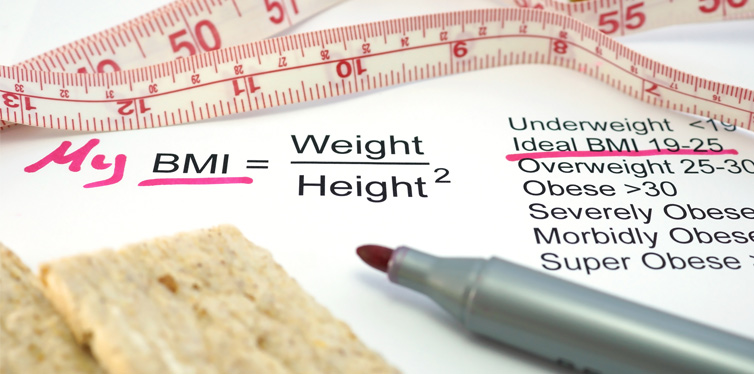Healthy BMI
Unless you’ve been on another planet you can’t have avoided hearing about BMI or Body Mass Index, with TV, magazines and may be even your own doctor telling you that you need to maintain a healthy one. But what does that actually mean in real terms for the average man on the street?
Where Did The Idea Of BMI Come From?
BMI was created in the beginning of the 20th century when medical research pointed to a link between dying early and excess body weight. Due to this, doctors began to look for an easier way of working out the percentage of body fat in an individual.
However, it wasn’t until 1972, when a study was published called “Indices of Relative Weight and Obesity” (an enthralling title) that today’s version of BMI was launched. In this study, several men were involved in research to test whether any pre-existing equations could work out the group’s relative percentage of body fat.
It was discovered that the Quetelet Index (put in simple terms, weight divided by height squared) did the job. Of course, BMI wasn’t intended to be used by doctors, however because it was so quick, cheap and easy to do when compared to more accurate and direct measures like the underwater weight test and skinfold measurement tests, it took off in a big way.
Over the years, BMI has become gradually more accepted as a go to standard formula for determining healthy body weights.

So, What Is My BMI?
A BMI is a measurement based on height and weight, giving you a guideline as to whether you’re underweight, overweight, obese or, hopefully, just right. If your BMI is too high, you’re believed to be at a higher risk of developing a range of medical problems including hypertension, type II diabetes and cardiovascular disease. Cheerful stuff indeed!
In days gone by, BMI was calculated in exactly the same way for everybody – by dividing body weight in kilos by height measured in square metres. However, these days, today’s BMI calculators have been fine-tuned, to a certain degree, to take gender into account too since men and women have a different physical make up and therefore aren’t comparable – tell us something we didn’t know!
How Is Body Mass Index Used By Doctors?
BMI may be a screening tool to identify potential weight problems in adults, but it’s important to note that it isn’t a diagnostic tool. This is because in some cases, BMI isn’t a good indicator of health.
Take, for example, an athlete with a very high muscle to body fat ratio. While their BMI may indicate that they are overweight, or even obese, and therefore unhealthy, this is clearly not the case and the results have been skewed by all that muscle. That means that if doctors are going to determine whether excess weight is really a problem for you, they have to carry out more assessments too such as measurements of skinfold thickness and evaluations of family history, level of physical activity and daily diet.
While in some cases BMI gives a false result because of a muscular or stocky frame, in others, it can give a false result because of lack of muscle. For all you guys who have never set foot in the gym – a word of warning – your BMI may come into a healthy range, but that doesn’t necessarily mean you’re at the peak of good health.
Why Is BMI Used To Measure Obesity?
BMI is popularly used to assess obesity simply because it is easy to do and doesn’t cost any money to work out. It doesn’t need to be carried out by a doctor – any member of the public can do it themselves and compare their body weight to that of the rest of the population.
The problem is, when members of the public start working out their BMI, they could easily get worried about their weight when there’s actually no need for concern. There are so many variations to take into account including age, race and gender, that it’s very easy to get it completely wrong.
For example, older people and women have a higher amount of body fat than younger men at the same BMI because women require a larger proportion of body fat to cope with the challenges of pregnancy and breastfeeding. This means that the percentage of body fat also has a role to play in determining obesity and BMI doesn’t take that into account at all which can lead to very misleading results.
What’s A Healthy BMI?
If you’re keen to know whether your BMI is in the right range to be considered healthy, here are the key figures:
- Under 18.5 – very underweight, maybe malnourished
- 5-24.9 – healthy weight for a young/middle aged adult
- 0-29.9 – overweight
- 30 or over – obese

If you’re looking at those figures and panicking because you’re coming up as obese even though you spend hours working out at the gym, don’t stress just yet. Remember, BMI doesn’t differentiate between muscle mass and body fat and that means that your body composition may well be the reason for your high BMI. Muscle mass is lean mass and that means that it’s healthy when compared to pure fat. It may weigh more than fat, but it will have a positive effect on your health and not a negative one.
To know for sure whether you could actually do with losing a few pounds, you should also check your waist size to see if that is also above average. Simply measuring your waist gives you a good insight into whether you have too much belly fat (or visceral fat, to give it its proper name). Visceral fat collects around the middle section of the body and functions similarly to another endocrine organ which secretes compounds which increase your chances of developing diseases. If your waist circumference is 40” or greater, you should probably look at shedding a few pounds by switching to a healthier lifestyle and getting outdoors to get a bit more exercise.
Conversely, even if your BMI is within the expected healthy range you could possibly benefit from losing some weight if you have a waist measurement which is larger than expected. That’s because a large waist circumference can lead to a number of health problems including:
- High blood pressure
- Type II diabetes
- Stroke
- Heart disease
- Sleep apnoea
- Osteoarthritis
- Gallbladder disease
- Breathing problems
- Some forms of cancer including colon and breast cancer
So, whatever your BMI result, it’s well worth getting out that tape measure and checking to see whether you are really putting your health at risk or not.










